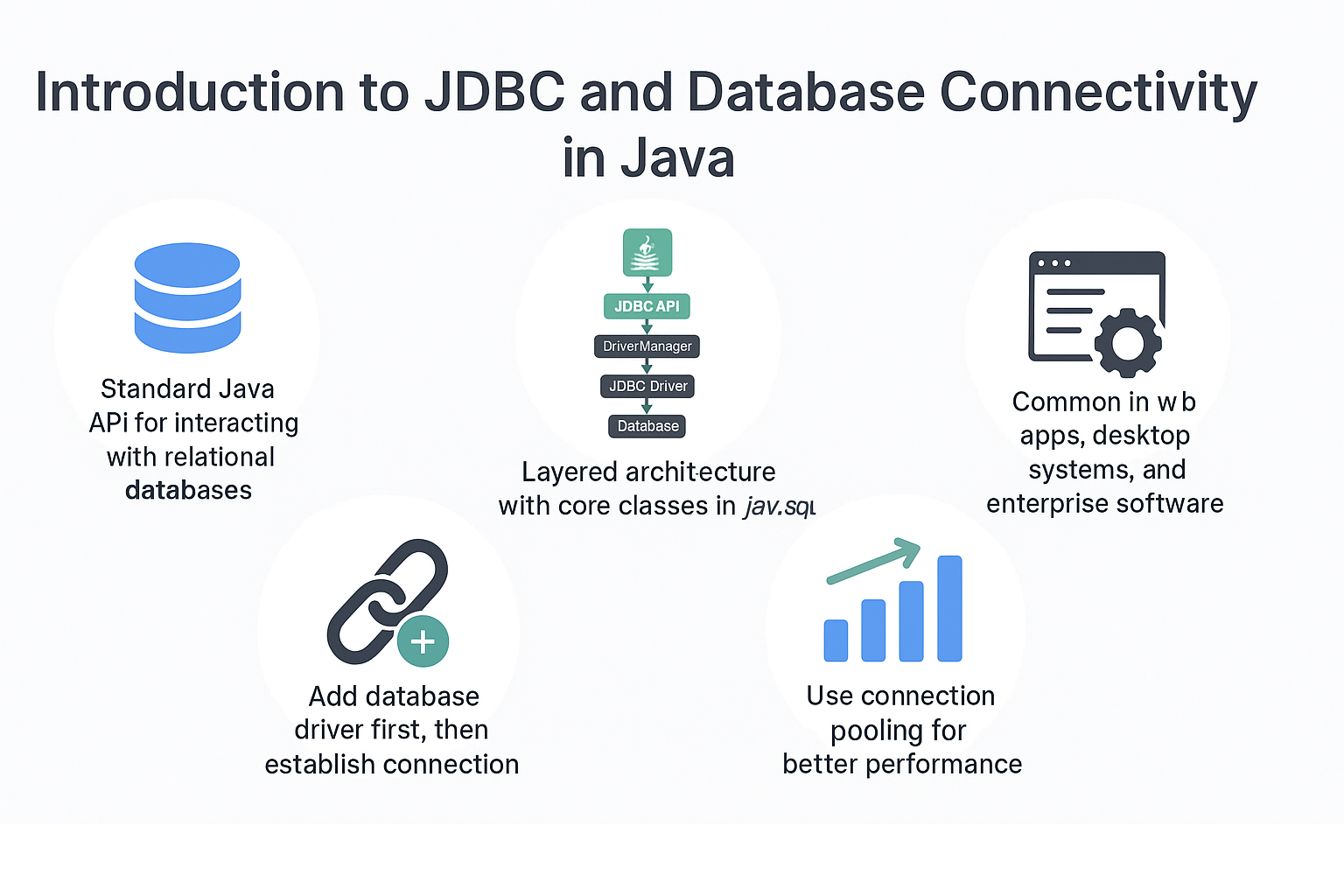Introduction
Java Database Connectivity (JDBC) is the standard API that enables Java applications to interact with relational databases. It acts as a bridge between Java code and databases like MySQL, PostgreSQL, Oracle, and SQL Server. JDBC is essential for enterprise applications, web backends, reporting tools, and any system that needs to store and retrieve structured data.
Why JDBC Matters
- Universal Database Access: JDBC provides a uniform way to connect to different databases.
- Industry Standard: It's part of Java SE and used in millions of applications worldwide.
- Foundation for ORM Tools: Frameworks like Hibernate and JPA are built on top of JDBC.
Core Concepts of JDBC
JDBC Architecture
JDBC follows a layered architecture:
- JDBC API – Provides interfaces and classes in
java.sql. - JDBC Driver Manager – Manages database drivers.
- JDBC Drivers – Implementations provided by database vendors.
- Database – The target relational database.
Java Application → JDBC API → JDBC Driver Manager → JDBC Driver → Database
Key JDBC Components
- DriverManager: Loads and manages database drivers.
- Connection: Represents a connection to the database.
- Statement: Executes SQL queries.
- PreparedStatement: Precompiled SQL statement for efficiency and security.
- ResultSet: Stores query results.
Real-World Use Cases
- Web Applications: E-commerce, CMS, and SaaS apps.
- Desktop Applications: Inventory management, reporting tools.
- Enterprise Systems: ERP, CRM, and banking software.
- Data Migration: ETL processes between systems.
Setting Up JDBC in Java
Step 1: Add Database Driver
For MySQL (Maven):
<dependency>
<groupId>mysql</groupId>
<artifactId>mysql-connector-java</artifactId>
<version>8.0.33</version>
</dependency>
For PostgreSQL (Maven):
<dependency>
<groupId>org.postgresql</groupId>
<artifactId>postgresql</artifactId>
<version>42.6.0</version>
</dependency>
Step 2: Establish Connection
import java.sql.*;
public class JDBCExample {
public static void main(String[] args) {
String url = "jdbc:mysql://localhost:3306/testdb";
String user = "root";
String password = "password";
try (Connection conn = DriverManager.getConnection(url, user, password)) {
System.out.println("Connected to the database!");
} catch (SQLException e) {
e.printStackTrace();
}
}
}
Step 3: Execute SQL Queries
String query = "SELECT id, name FROM employees";
try (Statement stmt = conn.createStatement();
ResultSet rs = stmt.executeQuery(query)) {
while (rs.next()) {
System.out.println(rs.getInt("id") + " - " + rs.getString("name"));
}
}
Statement vs PreparedStatement
| Feature | Statement | PreparedStatement |
|---|---|---|
| SQL Injection Safety | Vulnerable | Safe (uses parameter binding) |
| Performance | Re-parsed each execution | Precompiled, faster for repeats |
| Parameters | Hardcoded in query | Uses ? placeholders |
Example with PreparedStatement:
String sql = "INSERT INTO employees (name, role) VALUES (?, ?)";
try (PreparedStatement ps = conn.prepareStatement(sql)) {
ps.setString(1, "John Doe");
ps.setString(2, "Developer");
ps.executeUpdate();
}
Common Mistakes and Anti-Patterns
- Not closing resources: Always close
Connection,Statement,ResultSet. Use try-with-resources. - SQL Injection: Avoid concatenating user input in SQL queries.
- Hardcoding credentials: Use environment variables or config files.
- Ignoring Connection Pooling: Leads to performance bottlenecks.
Security Implications
- SQL Injection: Always use
PreparedStatement. - Least Privilege: Use DB users with minimal required permissions.
- Encrypt Connections: Use SSL/TLS when connecting to production databases.
Performance and Scalability
- Connection Pooling: Use libraries like HikariCP for efficient resource management.
- Batch Updates: Use
addBatch()andexecuteBatch()for bulk inserts/updates. - Indexing: Ensure database indexes for frequently queried columns.
Example: Batch Insert
String sql = "INSERT INTO logs (message) VALUES (?)";
try (PreparedStatement ps = conn.prepareStatement(sql)) {
for (int i = 0; i < 1000; i++) {
ps.setString(1, "Log entry " + i);
ps.addBatch();
}
ps.executeBatch();
}
Best Practices
- Always use try-with-resources.
- Use connection pooling in production.
- Separate SQL logic from business logic.
- Use database-specific JDBC drivers for better performance.
Real-World Analogy
Think of JDBC as a telephone operator. Your Java app calls the operator (JDBC), who connects you to different people (databases). You don’t need to know the wiring; you just use the API.
Conclusion & Key Takeaways
- JDBC is the backbone of Java-database communication.
- Always prioritize security (PreparedStatements, SSL).
- Use pooling for scalability.
- Close resources properly to avoid leaks.
FAQ
-
What is JDBC in Java?
JDBC is an API that allows Java applications to interact with relational databases. -
Which databases support JDBC?
Almost all major RDBMS including MySQL, PostgreSQL, Oracle, SQL Server, and SQLite. -
What are JDBC drivers?
They are vendor-specific implementations of the JDBC API. -
How to prevent SQL injection in JDBC?
UsePreparedStatementand parameterized queries. -
What is connection pooling?
A technique to reuse database connections for better performance. -
Is JDBC still used with ORM frameworks?
Yes, ORM frameworks internally use JDBC to communicate with the database. -
Can JDBC be used with NoSQL databases?
JDBC is mainly for relational databases; NoSQL databases have their own APIs. -
How to handle transactions in JDBC?
Useconn.setAutoCommit(false)andconn.commit()orconn.rollback(). -
Which is faster: Statement or PreparedStatement?
PreparedStatement is faster for repeated queries due to precompilation. -
How to choose between MySQL and PostgreSQL for JDBC?
Both are good; PostgreSQL offers advanced features, MySQL is simpler and widely used.
